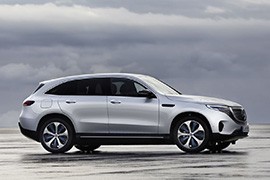MERCEDES BENZ EQC Models/Series Timeline, Specifications & Photos
First production year: 2019
Engines: Electric
Body style: SUV (Sports Utility Vehicle)
With the electric revolution already started, Mercedes-Benz had to work fast and launch electric models on the market to keep up with its competitors, and the EQC was the first model on its lineup. At the same time, it created the Mercedes-EQ as an electric-only brand.
The German automaker joined the bandwagon of the electric car revolution and introduced its first three-pointed star badged full-electric vehicle in 2019. Previously, Mercedes-Benz produced just the tiny smart fortwo with an electric drive, but the EQC was its first battery-based EV. It chose a crossover platform for that since it allowed it to install a larger battery in the floor. Moreover, even though it was its first EV, it was fitted with everything that a Mercedes-Benz customer had expected from this premium brand.
On the outside, the EQC featured a front fascia with a wide black panel at the front adorned by two horizontal chromed slats. It mimicked a grille, but since electric vehicles didn’t need large cooling areas, it was mostly covered. The headlights that flanked it featured LED technology for lower energy consumption, and, in the lower bumper, the automaker placed an A-shaped lower grille and two scoops and small vertical slats that improved aerodynamics. From its profile, the crossover revealed a steep windshield and a slightly sloped-down roofline emphasized by the window line, while at the back, the raked-forward tailgate adorned by a roof spoiler tried to create a dynamic look for the vehicle.
Inside, the automaker installed a pair of bucket seats at the front with mild bolstering and a bench seat for three in the back. The completely digital dashboard featured an instrument cluster fronting the driver, continued by the infotainment’s system screen placed atop the center stack. Both were covered by the same piece of glass, creating the image of a single, wide display. The steering wheel featured two metallic paddles behind it, similar to those used to change gears in ICE-powered vehicles, only here were used for the regenerative braking system. Between the front seats, Mercedes-Benz installed a center console that housed the controls for the MBUX infotainment system and a large storage area underneath the armrest. The trunk area could hold up to 501 liters (17.7 cu-ft.) of luggage, which could have been expanded by lowering the flat-folding rear bench’s seatback.
To power the vehicle, the automaker installed two electric motors, one for each axle, which provided up to 300 kW (408 PS, or 402 HP). But the main advantage was the instant torque of 765 Nm (564 lb-ft.) that could make all tires squeak at launch. Thanks to the 80 kWh battery pack, the vehicle promised a range of 450 km (280 miles) when driven efficiently.
